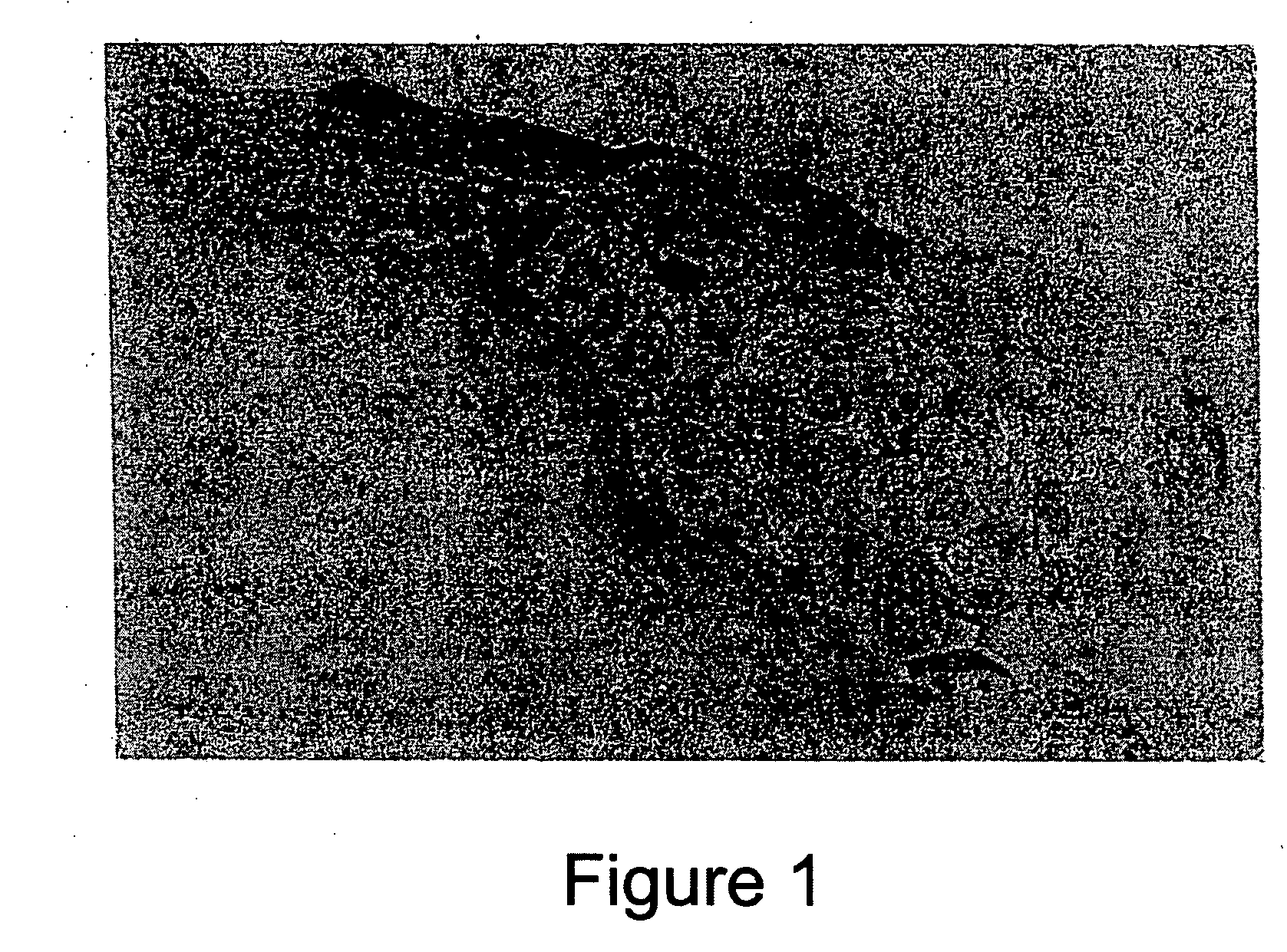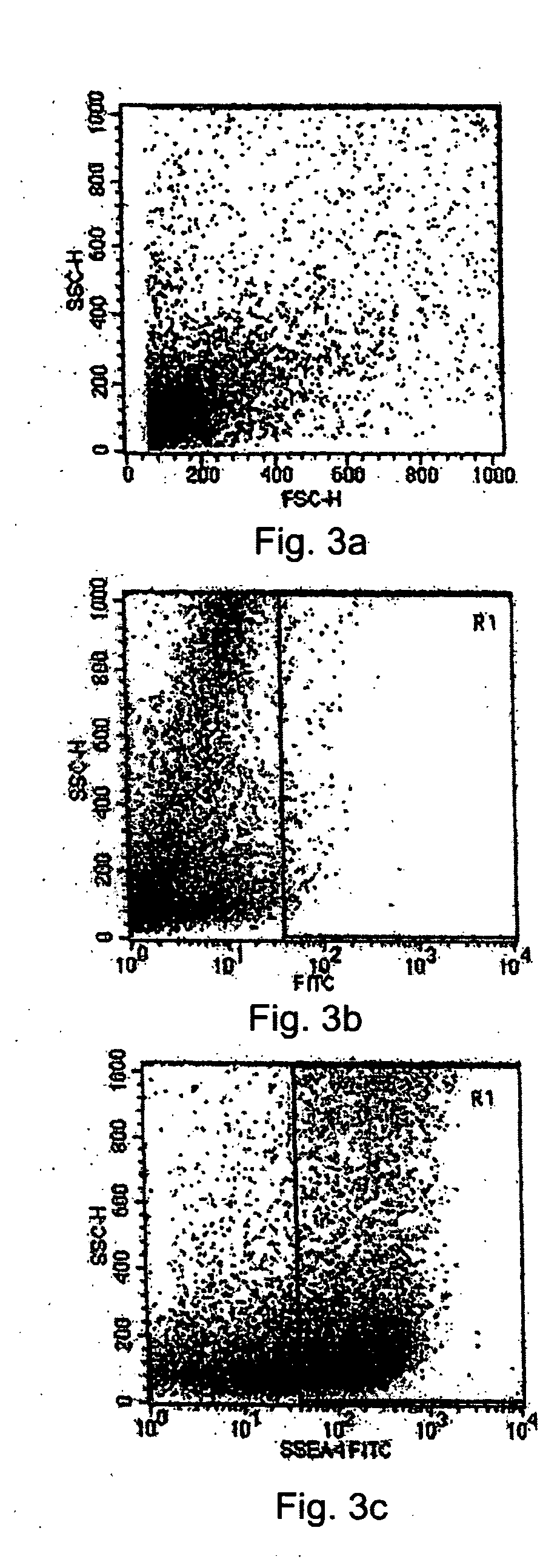Tissue system with undifferentiated stem cells derived from corneal limbus
a stem cell and tissue technology, applied in the field of tissue systems comprising mammalian undifferentiated stem cells, can solve the problems of amniotic membrane transplantation, insufficient approaches to repair damage related to or resulting from the loss of limbal stem cells, and unclear vision or ocular discomfor
- Summary
- Abstract
- Description
- Claims
- Application Information
AI Technical Summary
Benefits of technology
Problems solved by technology
Method used
Image
Examples
example 1
[0068] 1) Collection of Limbal Tissue Biopsies
[0069] Prior to initiating the collection of limbal tissue biopsies from human patients, Institutional Review Board approval was obtained. Informed consent was obtained from each patient and donor, and all human subjects were treated according to the Helsinki Accord. A 0.8 mm2to 2 mm2limbal biopsy was surgically removed from the donor eye from superior or temporal quadrants of the corneal surface by lamellar keratectomy. These regions are particularly rich in limbal stem cells. After excision, the biopsy was immediately placed in a 2 ml transport vial filled with transport medium. The transport medium consisted of Dulbecco's Modified Eagles Medium (DMEM) and Ham's F-12 Medium (DMEM:F-12; 1:1) supplemented with 5% fetal bovine serum (FBS) or 5% human serum collected from cord blood, 0.5% dimethyl sulphoxide (DMSO), 2 ng / ml recombinant human epidermal growth factor (rhEGF), 5 μg / ml insulin, 5 μg / ml transferrin, 5 μg / ml sodium selenite, 0....
example 2
[0084] Analysis and Characterization of the Tissue System Containing Undifferentiated Stem Cells
[0085] As outlined in Example 1, a tissue system comprising USCs was derived from limbal tissue biopsies. To better understand the cell population of the tissue system derived from limbal tissue, cells in the tissue system were analyzed using flow cytometry, immunofluorescence and immunoperoxidase assays, and molecular analysis for the presence or absence of various cellular markers of undifferentiated cells.
[0086] 1) Flow Cytometry Analysis
[0087] The cell population of the limbal biopsy cultures was compared to the cell population in the tissue system using flow cytometry analysis to detect the presence of the SSEA-4 marker. First, cells were collected from the limbal biopsy cultures at a semi-confluent stage and from the tissue system grown on an amniotic membrane tissue base after sorting and selecting cells by MACS as set forth above. The two populations of cells were analyzed sepa...
example 3
[0096] Viability Studies of the Tissue System Comprising Undifferentiated Stem Cells:
[0097] Limbal tissue biopsies were evaluated to determine how long the biopsies could remain in transport prior to in vitro culturing of a viable tissue system with USCs. The limbal tissue biopsies were transported or stored in the following culture media for 12, 24, 48, and 72 hours after surgery at 4° C.: DMEM and Ham's F-12 (ratio 1:1), supplemented with human cord blood serum (3-5%), DMSO (0.5%), rhEGF (2 ng / ml), insulin (5 μg / ml), transferrin (5 μg / m), sodium selenite (5 μg / ml), hydrocortisone (0.5 μg / ml), cholera toxin A (0.1 nmol / l ), gentamycin (50 μg / ml), and amphotericin B (1.25 μg / ml). After this period of time, the biopsies were cultured to generated tissue systems with USCs as described in Example 1. FIG. 13 shows the percent success in developing a tissue system from biopsies cultured approximately 12, 24, 48 and 72 hours after surgical collection from a subject. As shown in FIG. 13, ...
PUM
| Property | Measurement | Unit |
|---|---|---|
| limbal arc length | aaaaa | aaaaa |
| temperature | aaaaa | aaaaa |
| cell surface | aaaaa | aaaaa |
Abstract
Description
Claims
Application Information
 Login to View More
Login to View More - R&D
- Intellectual Property
- Life Sciences
- Materials
- Tech Scout
- Unparalleled Data Quality
- Higher Quality Content
- 60% Fewer Hallucinations
Browse by: Latest US Patents, China's latest patents, Technical Efficacy Thesaurus, Application Domain, Technology Topic, Popular Technical Reports.
© 2025 PatSnap. All rights reserved.Legal|Privacy policy|Modern Slavery Act Transparency Statement|Sitemap|About US| Contact US: help@patsnap.com



